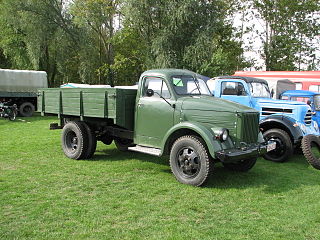
The GAZ-51 is a light truck manufactured by the Soviet vehicle manufacturer Gorkovsky Avtomobilny Zavod. The vehicle was designed before the Second World War and mass-produced together with the all-wheel-drive version GAZ-63 after the end of the war. Under the designation GAZ-93, a tipper was produced on the basis of the GAZ-51.
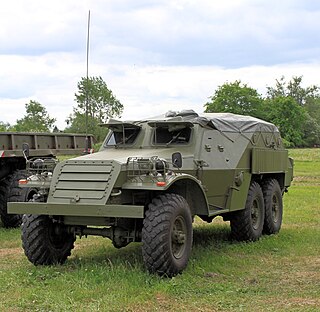
The BTR-152 is a six-wheeled Soviet armoured personnel carrier (APC) built on the chassis and drive train of a ZIS-151 utility truck. It entered service with a number of Warsaw Pact member states beginning in 1950, and formed the mainstay of Soviet motor rifle battalions until the advent of the amphibious BTR-60 series during the 1960s. BTR stands for bronetransportyor.

The 101 Forward Control or Land Rover 101FC was a light utility vehicle produced by Land Rover for the British Army. It was not available to the public off the production line, but was as military surplus.

The GAZ-69 is a Soviet four-wheel drive off-road vehicle produced by GAZ between 1953 and 1956 and then by UAZ between 1956 and 1972, though all of these light truck class vehicles were known as GAZ-69s. It was also produced in Romania until 1975.

The Studebaker US6 (G630) was a series of 2+1⁄2-ton 6×6 and 5-ton 6×4 trucks manufactured by the Studebaker Corporation and REO Motor Car Company during World War II. The basic cargo version was designed to transport a 2+1⁄2-short-ton cargo load over any type of terrain in any weather. Most of these were exported to the Soviet Union under Lend-Lease by the US during World War II, since the competing GMC 6×6 CCKW design proved to be more suitable for Western Front conditions.

The BTR-70 is an eight-wheeled armored personnel carrier originally developed by the Soviet Union during the late 1960s under the manufacturing code GAZ-4905. On August 21, 1972, it was accepted into Soviet service and would later be widely exported. Large quantities were also produced under license in Romania as the TAB-77.

The BTR-40 is a Soviet open-topped, wheeled armoured personnel carrier and reconnaissance vehicle. It is often referred to as the Sorokovka in Soviet service. It was eventually replaced in the APC role by the BTR-152 and in the scout car role by the BRDM-1.
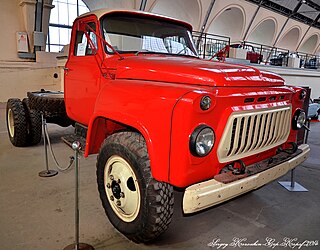
The GAZ-53 is a 3.5 tonne 4x2 truck produced by GAZ between 1961 and 1993. Introduced first as GAZ-53F, it was joined by the virtually identical 2.5-ton GAZ-52 in 1962, which was produced until 1989.
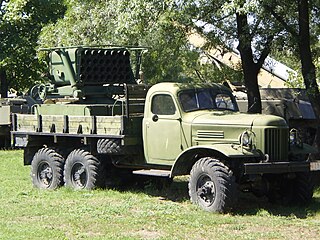
The ZIL-157 is a general-purpose 2+1⁄2-ton 6×6 truck, produced at the Likhachev plant in the Soviet Union from 1958 to 1977, when production was transferred to the Amur plant, since the Likhachev plant wanted to focus more on modern trucks, such as the ZIL-131 range. Nevertheless, production of the ZIL-157 trucks continued even after the fall of the Soviet Union, but eventually ended in 1994.

The ZIS-151 was a general-purpose truck produced by the Soviet car manufacturer Automotive Factory No. 2 Zavod imeni Stalina in 1948–1958. In 1956, the factory was renamed to Zavod imeni Likhacheva, and new trucks were called ZIL-151 (ЗИЛ-151).
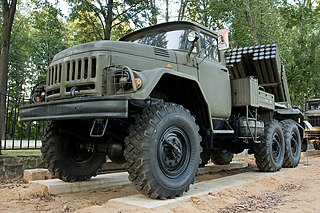
The ZIL-131 is a general purpose 3.5 tonne 6x6 army truck designed in the Soviet Union by ZIL. The basic model being a general cargo truck. Variants include a tractor-trailer truck, a dump truck, a fuel truck, and a 6x6 for towing a 4-wheeled powered trailer.

The UAZ-469 is an off-road military light utility vehicle manufactured by UAZ since 1971. It was used by Soviet and other Warsaw Pact armed forces, as well as paramilitary units in Eastern Bloc countries. In the Soviet Union, it also saw widespread service in state organizations that needed a robust and durable off-road vehicle. Standard military versions included seating for seven personnel.

The 2A36 Giatsint-B is a Soviet towed 152 mm (6.0 in) field gun which entered service in 1976, replacing the 130 mm (5.1 in) M-46 field gun.

The GAZ-24 "Volga" is a car manufactured by the Gorky Automobile Plant from 1970 to 1985 as a generation of its Volga marque. A largely redesigned version – GAZ-24-10 – was produced from 1985 to 1992. The Belgian-assembled rebadged models were sold as Scaldia-Volga M24 and M24D for the Western European market.

The ZIS-150 is a Soviet truck. In 1947 it replaced the ZIS-5 truck on the assembly line. Together with the GAZ-51, it was the main Soviet truck during the 1950s, judging by their quantity. A tractor-trailer version of the ZIS-150, the ZIS-120N was sold from 1956 to 1957. In 1957, the base ZIS-150 model was replaced by ZIL-164, which differed outwardly only by vertical grille bars and bumper.

The UAZ-452 is a family of four wheel drive off-road vans and light trucks with body-on-frame construction and cab over engine design, built by the Ulyanovsk Automobile Plant (UAZ) since 1965. Originally designed for the Soviet Armed Forces, since 1985 the vans received updates: more modern engines and internationally compliant lighting, as well as new model numbers, UAZ-3741 for the standard van, while (crew-cab) trucks mostly starting with UAZ-3303, often with one or two extra digits specifying the version. From around 1996, bigger UAZ-33036 truck variants with a 25 cm (10 in) longer wheelbase, and taller soft-top roof bows and drop-sides were added.

The GAZ Sobol is a series of Russian light-duty trucks, vans and minivans, produced by the Gorky Automobile Plant from November 1998. GAZ refers to the Sobol as a minivan.

The GAZ-3308 "Sadko" is a Russian-built, 2.5-ton, 4-wheel-drive cargo truck. The Sadko is produced by the Gorky Automobile Plant (GAZ). It is named after Sadko, a protagonist in many bylinas of the Novgorod cycle.

GAZ-3307 and GAZ-3309 are fourth-generation Russian trucks produced by the Gorky Automobile Plant. The GAZ-3307 was announced in late 1989, and the GAZ-3309 was announced at the end of 1994.
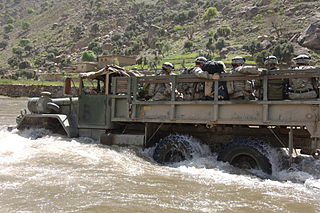
The M809 Series 5-ton 6x6 truck (G908) was a family of heavy tactical trucks built for the United States Armed Forces. The basic cargo version was designed to transport a 5-ton (4,500 kg), 14 ft (4.3 m) long load over all terrain in all weather. In on-road service the load weight was doubled. Built by AM General, they evolved into the M939 Series.



























